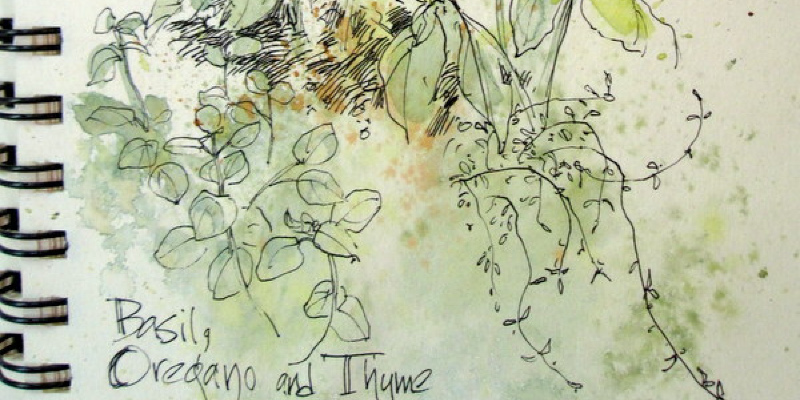Many preferred recipes for a Thanksgiving dinner call for fresh blossoms. But instead of rushing to market to find what you require, wouldn’t it be wonderful to just step outside your door? Fresh herbs not only pack a more appetizing punch than their dry counterparts, but they’re easy to grow in containers. Stock up on your favorite Thanksgiving herbs today to get a new source when it’s time to cook your turkey. Many nurseries as well as grocery shops have good-sized herb plants in 4-inch pots to put on your own patio or a sunny windowsill.
Inspired to start a long-term herb patch? You’ll also find planting info below to create an outdoor kitchen backyard with autumn’s favorite flavors when the weather warms back up.
Carolina Katz + Paula Nuñez
If your recipe calls for dried herbs, you can replace them with refreshing in a substitution ratio of 3:1. For example, if a recipe calls for 1 tsp of dried parsley, substitute 3 teaspoons of fresh.
Bonfigli Design
If your climate has mild winters, then you can keep pots outside. Otherwise, bring herbs inside for the autumn and winter. Most herbs require six hours of sun, so keep them in a bright spot, preferably one with immediate southern or eastern exposure.
Get the basics for growing herbs in containers
when the containers have been prepped and ready, choose which herbs to plant according to your favorite recipes. I’ve grouped suggested herbs by their soil and light requirements in case you opt to set them at precisely the exact same pot.
Jocelyn H. Chilvers
Sun-Loving, Low-Water Herbs
If I had to pick only 1 herb to be used for the Thanksgiving meal, it’d be sage. This potent herb works for poultry, stuffing and roasted vegetables. There’s very little difference in tastes between the types, so why don’t you choose ones which are pretty to look at — like a purple or variegated variety?
Sage
(Salvia officinalis)
USDA zones: 4 to 2 (find your zone)
Water requirement: Medium to arid, well-drained soil
moderate requirement: Full sun
Mature dimension: 2 to 2 1/2 feet tall and broad
Kim Gamel
Rosemary is just another herb typical in Thanksgiving dishes. It grows readily in pots, as a trailer or either vertical. It makes a good companion to cuddle at a pot.
Rosemary
(Rosmarinus officinalis)
USDA zones: 8 to 10
Water requirement: Medium to arid, well-drained soil
moderate condition: Entire sun
Mature size: Where winter is hardy, it might reach 3 to 6 ft tall and 3 to 4 ft wide
Kim Gamel
Seasons meats, soups and veggies wonderfully. While there are lots of varieties, lemon thyme, with its powerful citrus notes, is a personal favorite.
Thyme
(Thymus vulgaris)
USDA zones: 5 to 9
Water requirement Medium to arid, well-drained soil
moderate condition: Entire sun
Mature size: 6 inches to 1 foot tall and broad
Kim Gamel
Comparable to oregano, marjoram tastes somewhat sweeter and is less pungent. It is commonly found in the dried herb mixture herbes de Provence and often used in sauces, salad dressings and soups.
Marjoram
(Origanum majorana)
USDA zones: N/A; handle as an Yearly
Water requirement: Medium to arid, well-drained soil
moderate requirement: Full sun
Mature size: 1 foot to 2 feet tall and broad
Matthew Cunningham Landscape Design LLC
Not just for topping potato skins, chives are a really versatile and easy-growing herb. As a perennial in many areas of North America, it is going to come back every year, spreading into a bigger clump. For this reason you might choose to keep it in its pot so it doesn’t crowd out other plants.
Chives
(Allium schoenoprasum)
USDA zones: 4 to 8
Water requirement moderate humidity, well-drained soil
moderate condition: Full sun to partial shade
Mature size: 1 foot to 1 1/2 feet tall and broad
Kim Gamel
Tarragon’s powerful anise-like flavor is the main flavor connected with Béarnaise sauce. Its uses are almost unlimited — it works well with fish, meats, vegetables, eggs, salads, sauces and vinegars.
Tarragon
(Artemisia dracunculus ‘Sativa’)
USDA zones: 5 to 8
Water requirement: Medium to arid, well-drained soil
Light condition: Full sun
Mature size: 1 1/2 to 3 ft tall and broad
Kim Gamel
Moisture-Loving, Partial-Sun Herbs
Parsley is not just for garnishing your plate. It is rich in vitamins A and C and adds a wonderful mild flavor to dishes. It finishes dishes well when it’s chopped finely and sprinkled over the surface.
Italian (flat-leaf) parsley
(Petroselinum crispum)
USDA zones: N/A; handle as an Yearly
Water requirement Medium to moist, well-drained soil
moderate condition: Full sun to partial shade
Mature size: 9 inches to 1 foot tall and broad
Kim Gamel
Basil, though found mostly in foods, works in several dishes. Its leaves are the primary ingredient in pesto. You can even add the leaves directly to salads for a new, hot note. And, such as chamomile, it comes in a number of ornamental varieties, so it’s both useful and attractive. (Basil needs warm weather to grow, so plants might be more difficult to find in autumn.)
Basil
(Ocimum basilicum)
USDA zones: N/A; handle as an Yearly
Water requirement: Medium to moist, well-drained soil
moderate condition: Full sun to partial shade
Mature size: 1 1/2 to 2 feet tall and broad
Kim Gamel
Because mint could be invasive, it’s ideally suited for pot planting. Mint is quite versatile since it can flavor fruit and dessert dishes as well as savory dishes, like lamb chops.
Mint
(Mentha)
USDA zones: 5 to 9
Water requirement: Medium to moist, well-drained soil
moderate condition: Full sun to partial shade
Mature size: 1 foot to 2 feet tall and broad
Inform us : What herbs can you keep inside in autumn and winter?
